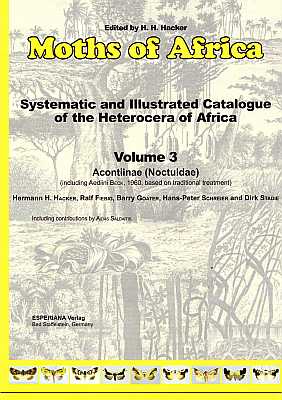STADIE, B (1 résultats)
Type d'article
- Tous les types d'articles
- Livres (1)
- Magazines & Périodiques
- Bandes dessinées
- Partitions de musique
- Art, Affiches et Gravures
- Photographies
- Cartes
-
Manuscrits &
Papiers anciens
Etat
- Tous
- Neuf
- Ancien ou d'occasion
Reliure
- Toutes
- Couverture rigide
- Couverture souple
Particularités
- Edition originale
- Signé
- Jaquette
- Avec images
- Sans impression à la demande
Pays
Evaluation du vendeur
-
Moths of Africa - Systematic and Illustrated Catalogue of the Heterocera of Africa, Vol. 3: Acontiinae (Noctuidae) (Including Aediini Beck, 1960, Based on Traditional Treatment)
Date d'édition : 2022
Vendeur : ConchBooks, Harxheim, Allemagne
Species of the Acontiinae (Lepidoptera, Noctuidae) are well-known from their often typical facies and spectacular bird-dropping mimics. The species of the Old World were revised by Hacker et al. (2008), those of the New World by Lafontaine & Poole (2010), with some variance with the systematic treatment. The phylogeny-based classification of Noctuidae using molecular markers as a basis for noctuid phylogenetics and higher-level classification led to new subfamilial groupings and a more robust assessment of relationships. The Aediini, attributed so far as a tribe of Acontiinae, were found by Keegan et al. (2021) apart from any recognized subfamily. The placement of the group of the eponymous genus Aedia Hübner, [1823], comprising numerous African species needs further study. Provisionally, it is included in the present treatment as an independent complex Aediinae. In the present volume 374 African species of the subfamily Acontiinae are described and figured. Of each species, a diagnosis and the geographical range are given, and when known, details of habitat preference and biology. All species are presented with their full name and references to the original description, with fully referenced synonyms. Special emphasis is given to descriptions and coloured illustrations, and to figures of genitalia features of both sexes, which were selected from more than 3,000 dissections. Male and female genitalia of nearly all species are illustrated and distribution maps are provided. All species are arranged in biogeographical categories, according to the definitions of those units in the first volume of the series. DNA sequencing was performed for about half of the species. The handling of the sequence divergences for the barcode region follows Ratnasingham & Hebert (2007) using the Kimura 2 Parameter model, employing the analytical tools on BOLD (cf. Hausmann, 2011). The results of DNA sequencing are specified in eight tables with Neighbour Joining Trees. All sequence records, trace files and images are available and accessible in the Barcode of Life Data System (Ratnasingham & Hebert 2007). This review of the African Acontiinae includes descriptions of five genera, three subgenera, 30 species and three subspecies new to science. 695 pp., 186 color plates of genitalia, 52 color plates showing specimens, 10 color plates with photos of larvae, imagines and landscape, hardcover gr. 8 [17.3 x 24.5 cm].


